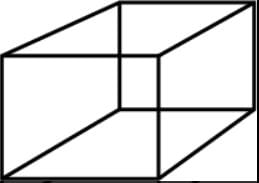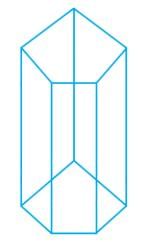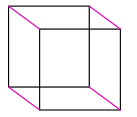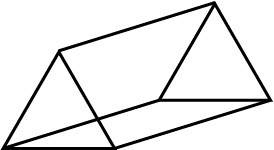All Exams >
Class 5 >
Mathematics for Class 5: NCERT >
All Questions
All questions of Chapter 9 - Boxes And Sketches for Class 5 Exam
A Dice has___________ faces?- a)4
- b)6
- c)8
- d)12
Correct answer is option 'B'. Can you explain this answer?
A Dice has___________ faces?
a)
4
b)
6
c)
8
d)
12
|
|
Shubham mishra answered |
The above figure is of a cube.
We know that dice is generally used in LUDO and snake Leader game.
Dice is cube shaped, as shown in the figure.

Therefore a dice has six faces.
What is the shape of each face of a cuboid?- a)Rectangular
- b)Circular
- c)Triangular
- d)None of these
Correct answer is option 'A'. Can you explain this answer?
What is the shape of each face of a cuboid?
a)
Rectangular
b)
Circular
c)
Triangular
d)
None of these
|
|
Avinash Patel answered |
The face of cuboid is in the shape of a rectangle. So, option A is correct.
The side view of the pentagonal prism is

- a)Pentagon
- b)Square
- c)Rectangle
- d)Parallellogram
Correct answer is option 'D'. Can you explain this answer?
The side view of the pentagonal prism is


a)
Pentagon
b)
Square
c)
Rectangle
d)
Parallellogram
|
|
Shubham mishra answered |
Side view looks like a parallelogram.
The sum of two opposite faces of a Dice is always _______.- a)4
- b)5
- c)6
- d)7
Correct answer is option 'D'. Can you explain this answer?
The sum of two opposite faces of a Dice is always _______.
a)
4
b)
5
c)
6
d)
7
|
|
Shubham mishra answered |
The sum of opposite faces of a regular dice is always 7.

A square pyramid has a ______ as its base.- a)Triangle
- b)Square
- c)Rectangle
- d)Pyramid
Correct answer is option 'B'. Can you explain this answer?
A square pyramid has a ______ as its base.
a)
Triangle
b)
Square
c)
Rectangle
d)
Pyramid
|
|
Harshitha Singh answered |
The correct answer is option 'B' - Square.
Square Pyramid:
A square pyramid is a type of pyramid where the base is a square. It is a three-dimensional geometric shape with a square base and four triangular faces that meet at a single point called the apex or vertex. The height of the pyramid is the perpendicular distance from the apex to the base.
Explanation:
To understand why the correct answer is option 'B' - Square, let's break down the pyramid and its properties:
1. Base:
- The base of a pyramid is the bottom face upon which the pyramid stands.
- In the case of a square pyramid, the base is a square.
- A square is a quadrilateral with all four sides equal in length and all four angles equal to 90 degrees.
2. Faces:
- A pyramid has triangular faces that converge to a single point called the apex.
- In the case of a square pyramid, it has four triangular faces.
- Each face of the pyramid is a right-angled triangle, where one side is the height of the pyramid, and the other two sides are the slant height of the pyramid.
3. Apex:
- The apex is the topmost point of the pyramid where all the triangular faces meet.
- In the case of a square pyramid, the apex is directly above the center of the square base.
4. Height:
- The height of a pyramid is the perpendicular distance from the apex to the base.
- In the case of a square pyramid, the height is the distance from the apex to the center of the square base.
- The height is not necessarily equal to the slant height of the pyramid or the length of its sides.
Therefore, based on the definition and properties of a square pyramid, we can conclude that a square pyramid has a square as its base.
Square Pyramid:
A square pyramid is a type of pyramid where the base is a square. It is a three-dimensional geometric shape with a square base and four triangular faces that meet at a single point called the apex or vertex. The height of the pyramid is the perpendicular distance from the apex to the base.
Explanation:
To understand why the correct answer is option 'B' - Square, let's break down the pyramid and its properties:
1. Base:
- The base of a pyramid is the bottom face upon which the pyramid stands.
- In the case of a square pyramid, the base is a square.
- A square is a quadrilateral with all four sides equal in length and all four angles equal to 90 degrees.
2. Faces:
- A pyramid has triangular faces that converge to a single point called the apex.
- In the case of a square pyramid, it has four triangular faces.
- Each face of the pyramid is a right-angled triangle, where one side is the height of the pyramid, and the other two sides are the slant height of the pyramid.
3. Apex:
- The apex is the topmost point of the pyramid where all the triangular faces meet.
- In the case of a square pyramid, the apex is directly above the center of the square base.
4. Height:
- The height of a pyramid is the perpendicular distance from the apex to the base.
- In the case of a square pyramid, the height is the distance from the apex to the center of the square base.
- The height is not necessarily equal to the slant height of the pyramid or the length of its sides.
Therefore, based on the definition and properties of a square pyramid, we can conclude that a square pyramid has a square as its base.
Identify the shape that can be formed using the following net.

- a)Cube
- b)Rectangle box
- c)None of these
- d)Triangle prism
Correct answer is option 'B'. Can you explain this answer?
Identify the shape that can be formed using the following net.


a)
Cube
b)
Rectangle box
c)
None of these
d)
Triangle prism

|
Sankhya Sadhu answered |
In the above diagram, the sideway part of the net is a rectangle. In fact all of the parts of the net is rectangle. As we all know that rectangles have six phases (rectangles), it's going to be easy. let's turn the sideway part of the net upwards. Ok cool... Now we have to turn the down part of the net upwards. okk coollll.... now we fold every single part of the net we have not discussed upwards. see, it becomes a rectangle or a 3d triangle. Thus, option B is correct!
If it helpful then consider upvoting my answer
If it helpful then consider upvoting my answer
A cube has _____ faces.- a)4
- b)6
- c)8
- d)10
Correct answer is option 'B'. Can you explain this answer?
A cube has _____ faces.
a)
4
b)
6
c)
8
d)
10
|
|
Yash Sengupta answered |
A cube has 6 faces.
Explanation:
A cube is a three-dimensional shape that has six equal square faces. It is one of the five Platonic solids, which are regular, convex polyhedra.
Each face of a cube is a square, and all six faces are identical in shape and size. The edges of a cube are all the same length, and they meet at right angles.
The faces of a cube are arranged in a way that every vertex is connected to three edges, and three faces meet at each vertex. This creates a highly symmetrical shape with equal angles and edges.
The six faces of a cube are labeled as follows:
1. Top face: This is the face that is opposite to the bottom face and is parallel to it.
2. Bottom face: This is the face that is opposite to the top face and is parallel to it.
3. Front face: This is the face that is opposite to the back face and is parallel to it.
4. Back face: This is the face that is opposite to the front face and is parallel to it.
5. Left face: This is the face that is opposite to the right face and is parallel to it.
6. Right face: This is the face that is opposite to the left face and is parallel to it.
All six faces of a cube are interconnected by its edges and vertices, forming a solid shape. The cube is a highly symmetrical figure that is commonly used in mathematics and geometry. It has various applications in architecture, engineering, and computer graphics.
Explanation:
A cube is a three-dimensional shape that has six equal square faces. It is one of the five Platonic solids, which are regular, convex polyhedra.
Each face of a cube is a square, and all six faces are identical in shape and size. The edges of a cube are all the same length, and they meet at right angles.
The faces of a cube are arranged in a way that every vertex is connected to three edges, and three faces meet at each vertex. This creates a highly symmetrical shape with equal angles and edges.
The six faces of a cube are labeled as follows:
1. Top face: This is the face that is opposite to the bottom face and is parallel to it.
2. Bottom face: This is the face that is opposite to the top face and is parallel to it.
3. Front face: This is the face that is opposite to the back face and is parallel to it.
4. Back face: This is the face that is opposite to the front face and is parallel to it.
5. Left face: This is the face that is opposite to the right face and is parallel to it.
6. Right face: This is the face that is opposite to the left face and is parallel to it.
All six faces of a cube are interconnected by its edges and vertices, forming a solid shape. The cube is a highly symmetrical figure that is commonly used in mathematics and geometry. It has various applications in architecture, engineering, and computer graphics.
Is sphere, a 2D or a 3D object?- a)2D
- b)3D
- c)Does not exist in both planes
- d)None of the above
Correct answer is option 'B'. Can you explain this answer?
Is sphere, a 2D or a 3D object?
a)
2D
b)
3D
c)
Does not exist in both planes
d)
None of the above
|
|
Dipanjan Chatterjee answered |
Understanding Dimensions
In geometry, objects are classified based on their dimensions, which refer to how many directions or axes they extend into.
What is a Sphere?
- A sphere is defined as a perfectly round 3D shape where every point on its surface is equidistant from its center.
- Examples of spheres include everyday objects like basketballs, globes, and bubbles.
2D vs 3D Objects
- 2D Objects: These shapes have only two dimensions - length and width. They exist on a flat plane and have no depth. Examples include circles, squares, and triangles.
- 3D Objects: These shapes have three dimensions - length, width, and depth. They occupy space and can be measured in all three directions. Examples include cubes, cylinders, and spheres.
Why is a Sphere a 3D Object?
- Since a sphere has depth, along with length and width, it fits the definition of a 3D object.
- The surface of a sphere can be visualized as having volume, which is not the case for 2D shapes.
Conclusion
Given the characteristics of a sphere, it is clear that it is a three-dimensional object, making the correct answer option 'B'. Understanding these distinctions helps in visualizing and categorizing different geometric shapes accurately.
In geometry, objects are classified based on their dimensions, which refer to how many directions or axes they extend into.
What is a Sphere?
- A sphere is defined as a perfectly round 3D shape where every point on its surface is equidistant from its center.
- Examples of spheres include everyday objects like basketballs, globes, and bubbles.
2D vs 3D Objects
- 2D Objects: These shapes have only two dimensions - length and width. They exist on a flat plane and have no depth. Examples include circles, squares, and triangles.
- 3D Objects: These shapes have three dimensions - length, width, and depth. They occupy space and can be measured in all three directions. Examples include cubes, cylinders, and spheres.
Why is a Sphere a 3D Object?
- Since a sphere has depth, along with length and width, it fits the definition of a 3D object.
- The surface of a sphere can be visualized as having volume, which is not the case for 2D shapes.
Conclusion
Given the characteristics of a sphere, it is clear that it is a three-dimensional object, making the correct answer option 'B'. Understanding these distinctions helps in visualizing and categorizing different geometric shapes accurately.
The side view of the given cube is

- a)Square
- b)Triangle
- c)Circle
- d)Parallelogram
Correct answer is option 'A'. Can you explain this answer?
The side view of the given cube is

a)
Square
b)
Triangle
c)
Circle
d)
Parallelogram

|
Torcia Education answered |
Students should note that the side view, front view, and top view of any cube will always look square because all the faces of the cube are the same.
The net of a cube contains ______ squares.- a)4
- b)6
- c)8
- d)10
Correct answer is option 'B'. Can you explain this answer?
The net of a cube contains ______ squares.
a)
4
b)
6
c)
8
d)
10
|
|
Saikat Chavan answered |
The net of a cube is a two-dimensional representation of a three-dimensional cube that can be folded to form the cube. It consists of six equal squares, each representing a face of the cube. Therefore, the correct answer is option 'B' - 6 squares.
Explanation:
A cube is a three-dimensional solid object with six square faces, twelve edges, and eight vertices. When a cube is unfolded along its edges and flattened out, it forms a two-dimensional shape called the net of the cube.
The net of a cube consists of six squares, where each square represents one face of the cube. These squares are connected at their edges and corners to form the complete net. By folding along the edges, the net can be transformed into a three-dimensional cube.
Each square in the net represents one face of the cube, and there are six faces in total. Therefore, the net of a cube contains six squares.
To visualize this, imagine taking a cardboard box and cutting along the edges to create a flat net. Once you flatten out the cardboard, you will see that it consists of six squares, each representing a face of the cube.
In summary, the net of a cube contains six squares, each representing one face of the cube.
Explanation:
A cube is a three-dimensional solid object with six square faces, twelve edges, and eight vertices. When a cube is unfolded along its edges and flattened out, it forms a two-dimensional shape called the net of the cube.
The net of a cube consists of six squares, where each square represents one face of the cube. These squares are connected at their edges and corners to form the complete net. By folding along the edges, the net can be transformed into a three-dimensional cube.
Each square in the net represents one face of the cube, and there are six faces in total. Therefore, the net of a cube contains six squares.
To visualize this, imagine taking a cardboard box and cutting along the edges to create a flat net. Once you flatten out the cardboard, you will see that it consists of six squares, each representing a face of the cube.
In summary, the net of a cube contains six squares, each representing one face of the cube.
Faces of the cube are in shape of _______- a)Square
- b)Rectangle
- c)Circle
- d)Triangle
Correct answer is option 'A'. Can you explain this answer?
Faces of the cube are in shape of _______
a)
Square
b)
Rectangle
c)
Circle
d)
Triangle
|
|
Avinash Patel answered |
Faces of the cube are in the shape of square.
The plane shapes which have two measurements like length and breadth is known as _______- a)2D Shapes
- b)3D Shapes
- c)4D Shapes
- d)None of the above
Correct answer is option 'A'. Can you explain this answer?
The plane shapes which have two measurements like length and breadth is known as _______
a)
2D Shapes
b)
3D Shapes
c)
4D Shapes
d)
None of the above
|
|
Maulik Chauhan answered |
2D Shapes
Two-dimensional (2D) shapes are flat shapes that only have two measurements - length and breadth. These shapes are also known as plane shapes because they exist on a flat surface, like a piece of paper or a chalkboard. The term "plane" refers to a flat, two-dimensional surface.
Examples of 2D Shapes
- Square: A square is a four-sided shape with equal length and breadth. It has four right angles.
- Rectangle: A rectangle is a four-sided shape with opposite sides of equal length. It also has four right angles.
- Triangle: A triangle is a three-sided shape with three angles. It can have different types such as equilateral (all sides and angles are equal), isosceles (two sides and two angles are equal), or scalene (no sides or angles are equal).
- Circle: A circle is a shape with no sides or angles. It is defined by a curved line called the circumference, which is equidistant from a fixed point called the center.
- Pentagon: A pentagon is a five-sided shape with five angles. All angles in a regular pentagon are equal.
Difference Between 2D and 3D Shapes
The main difference between 2D and 3D shapes is that while 2D shapes only have two measurements (length and breadth), 3D shapes have a third measurement called height or depth. 3D shapes are objects that have thickness or volume and can be seen from different angles.
Examples of 3D shapes include cubes, cylinders, spheres, and pyramids. Unlike 2D shapes, 3D shapes have faces, edges, and vertices. Faces are the flat surfaces of the shape, edges are the lines where two faces meet, and vertices are the corners or points where multiple edges meet.
Conclusion
In conclusion, the plane shapes that have two measurements - length and breadth - are known as 2D shapes. These shapes exist on a flat surface and do not have thickness or volume. Examples of 2D shapes include squares, rectangles, triangles, circles, and pentagons.
Two-dimensional (2D) shapes are flat shapes that only have two measurements - length and breadth. These shapes are also known as plane shapes because they exist on a flat surface, like a piece of paper or a chalkboard. The term "plane" refers to a flat, two-dimensional surface.
Examples of 2D Shapes
- Square: A square is a four-sided shape with equal length and breadth. It has four right angles.
- Rectangle: A rectangle is a four-sided shape with opposite sides of equal length. It also has four right angles.
- Triangle: A triangle is a three-sided shape with three angles. It can have different types such as equilateral (all sides and angles are equal), isosceles (two sides and two angles are equal), or scalene (no sides or angles are equal).
- Circle: A circle is a shape with no sides or angles. It is defined by a curved line called the circumference, which is equidistant from a fixed point called the center.
- Pentagon: A pentagon is a five-sided shape with five angles. All angles in a regular pentagon are equal.
Difference Between 2D and 3D Shapes
The main difference between 2D and 3D shapes is that while 2D shapes only have two measurements (length and breadth), 3D shapes have a third measurement called height or depth. 3D shapes are objects that have thickness or volume and can be seen from different angles.
Examples of 3D shapes include cubes, cylinders, spheres, and pyramids. Unlike 2D shapes, 3D shapes have faces, edges, and vertices. Faces are the flat surfaces of the shape, edges are the lines where two faces meet, and vertices are the corners or points where multiple edges meet.
Conclusion
In conclusion, the plane shapes that have two measurements - length and breadth - are known as 2D shapes. These shapes exist on a flat surface and do not have thickness or volume. Examples of 2D shapes include squares, rectangles, triangles, circles, and pentagons.
Chapter doubts & questions for Chapter 9 - Boxes And Sketches - Mathematics for Class 5: NCERT 2025 is part of Class 5 exam preparation. The chapters have been prepared according to the Class 5 exam syllabus. The Chapter doubts & questions, notes, tests & MCQs are made for Class 5 2025 Exam. Find important definitions, questions, notes, meanings, examples, exercises, MCQs and online tests here.
Chapter doubts & questions of Chapter 9 - Boxes And Sketches - Mathematics for Class 5: NCERT in English & Hindi are available as part of Class 5 exam.
Download more important topics, notes, lectures and mock test series for Class 5 Exam by signing up for free.
Mathematics for Class 5: NCERT
31 videos|192 docs|41 tests
|

Contact Support
Our team is online on weekdays between 10 AM - 7 PM
Typical reply within 3 hours
|
Free Exam Preparation
at your Fingertips!
Access Free Study Material - Test Series, Structured Courses, Free Videos & Study Notes and Prepare for Your Exam With Ease

 Join the 10M+ students on EduRev
Join the 10M+ students on EduRev
|

|
Create your account for free
OR
Forgot Password
OR
Signup to see your scores
go up within 7 days!
Access 1000+ FREE Docs, Videos and Tests
Takes less than 10 seconds to signup












